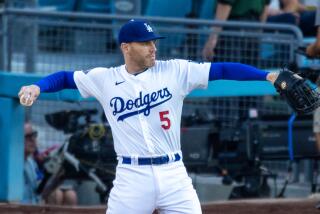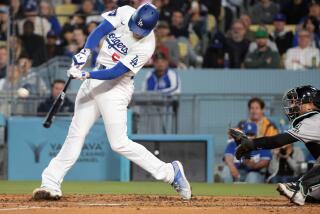Freemark, Ahead of Its Time
Wine advertising is notoriously boring. You’ve got your bottle shot, your chateau-winery shot, your idyllic situation shot and your photogenic winemaker posing as somebody with a scintillating personality shot. That’s just about it--in a word, humorless. But every once in a while something interesting comes along.
One of my all-time favorites is an ad for Freemark Abbey that appeared in magazines a few years ago. It featured a full-page shot of a couple of good ol’ boys in overalls standing in a vineyard, tasting grapes right off the vine. The caption read, “Two of the hip, trendy guys who bring you Napa Valley wine.”
The ad’s humor comes from a sly contradiction of the viewer’s preconceived notions: that farmers aren’t sophisticated and that Napa Valley vintners are all dot-com gazillionaires making the glamorous wine country lifestyle scene. The good ol’ boys in the picture are Freemark Abbey founding partners Chuck Carpy (who died in August 1996, not long after the ad ran) and Laurie Wood, two of the most respected wine men in Napa Valley history.
In fact, when Carpy, Wood and five other partners made their first Freemark Abbey wines in 1967, they actually were hip and trendy. For perspective, consider that they were a year ahead of Robert Mondavi, two years ahead of Chappellet, five years ahead of Clos du Val, Stag’s Leap Wine Cellars and Chateau Montelena.
They anticipated by a decade the explosion of small quality-oriented California wineries in the 1970s and beat the first of the current crop of over-hyped cult Cabs by a quarter of a century. And the fact that Freemark Abbey remains a blue-chip producer more than 30 years later is precisely because those guys were farmers from the get-go.
That’s why it was no accident that Freemark Abbey’s unctuous Chardonnays helped establish the California Chardonnay style that most of the world practically worships today (“Getting at the flavors of these wines would be a lifework for a poet,” wrote Bob Thompson in his 1988 book “Notes on a California Cellar Book” [William Morrow, 1988]). They were also ahead of the curve with varietal Merlot. Freemark Abbey’s sister winery, Rutherford Hill, specialized in Merlot made primarily from the vineyards of partner Bill Jaeger.
But it was Freemark Abbey’s Cabernet Sauvignons--especially the single-vineyard bottling from grower John Bosche’s superb Rutherford planting--that made the earliest and most lasting impression on the wine-scape. Cabernet Bosche is one of the pillars of Napa Valley’s reputation. The wines are valued not only for their sensual beauty and capacity for long aging but also as singular expressions (enhanced by dry-farming) of both vintage and terroir.
The 22-acre Bosche vineyard is on well-drained alluvial ground in Rutherford. It’s among the valley’s most privileged sites. Cabernet Bosche typically shows a touch of the graphite-like scent of clean dirt that longtime Beaulieu wine master Andre Tchelistcheff called Rutherford dust--not surprising in light of the fact that the vineyard is adjacent to Beaulieu Vineyard’s famous BV#1, the source of Georges de Latour Private Reserve.
Rutherford was one of the earliest parts of the Napa Valley to produce wine. When Napa Valley pioneer George C. Yount arrived in 1838, he was given 11,814 acres by Gen. M.G. Vallejo, Mexico’s colonial governor in Alta California; the land grant still appears as Caymus Rancho on U.S. Geological Survey maps of the valley. Twenty-six years later, Yount’s granddaughter Elizabeth married Thomas Rutherford. As a wedding gift from Grandpa, they received 1,040 acres of Caymus Rancho at a relatively wide spot in the valley between modern-day Oakville and St. Helena.
Four years after the wedding, a railroad line was extended up the valley, with a stop among the burgeoning vines at Rutherford Station. Thus the Rutherfords gave their name to what would eventually become some of the most revered viticultural land in California.
John Bosche, who was born in Chile and became a successful San Francisco attorney, bought a vacation home in Rutherford in the mid-1950s. The property came with an old vineyard made up of diverse grape varieties. Not all of them were, shall we say, noble. Bosche began replanting to Cabernet Sauvignon in 1961. Laurie Wood was his viticultural consultant. It was a no-brainer to sell the first crops to neighboring Beaulieu, but Bosche was always a little frustrated to see his grapes subsumed into various BV blends (including the Private Reserve in some years).
He kept his eye out for a producer who might want to make a vineyard-designated wine from his vineyard. That became a real possibility when Wood, Carpy and four other partners founded Freemark Abbey in 1967. A year later, Freemark Abbey made three barrels of wine from Bosche’s Cabernet. BV had already spoken for all the fruit in ‘69, but the next year Carpy and his partners were able to buy half of the vineyard’s yield. Beginning in ’71 they had complete control of the vineyard and all of its fruit, producing a few thousand cases of Cabernet Bosche each year.
Merlot was blended into Cabernet Bosche from the start, another hip, trendy move in its time. At first the Merlot component came from one of the partners’ vineyards on Zinfandel Lane, but they began planting Merlot on the Bosche property in the mid-70s. Today the vineyard is about 15% Merlot.
The 1970 Freemark Abbey Cabernet Bosche was the first in a sequence that now stands at 30 vintages. Among single-vineyard Napa Cabernets, only the BV Private Reserve and the Martha’s Vineyard bottling from Heitz Cellar has had a longer run.
I recently delved into that liquid history in a retrospective tasting with partner-marketing director Catherine Carpy (Chuck’s daughter) and managing partner Ted Edwards, who has been Freemark Abbey’s winemaker for 15 years.
I’m happy to report that the ’70 Bosche is still gorgeous: beautifully firm and vibrant, with a concentrated succulence that probably reflects the natural crop-thinning of that year’s relentless frost season, one of the worst on record. The ’76 was nearly as impressive, perhaps more radiant but not quite as deep and powerful, probably as the result of late-season dehydration in an extreme drought year that saw less than a third of normal rainfall.
The ‘80, once a candidate for tannic monster status, is a case study in a Bosche wine’s ability to bloom and soften over time. The ‘86, just opening into full maturity, seemed to me like a younger ‘80--which could be seen as a younger ‘76, itself a younger ’70.
The wines showed a remarkable continuity of Bosche character (tobacco-like earthiness and a touch of green olive, among other things) through each discrete expression of a particular growing season.
The vineyard has continued to evolve. The partners began replanting and upgrading it in the ‘80s, before “clone” and “rootstock” became buzzwords.
The winemaking evolves, too. Throughout the ‘90s, Edwards’ Cabernet Bosches have been noticeably more luscious and approachable in youth, quietly but firmly on the leading edge of Napa Valley style. That, it seems, is the Freemark Abbey way.
More to Read
Eat your way across L.A.
Get our weekly Tasting Notes newsletter for reviews, news and more.
You may occasionally receive promotional content from the Los Angeles Times.










